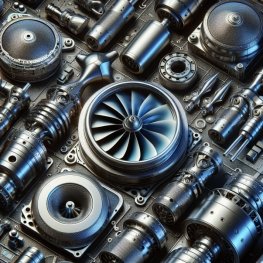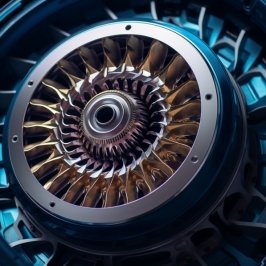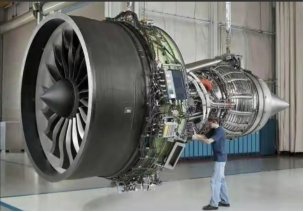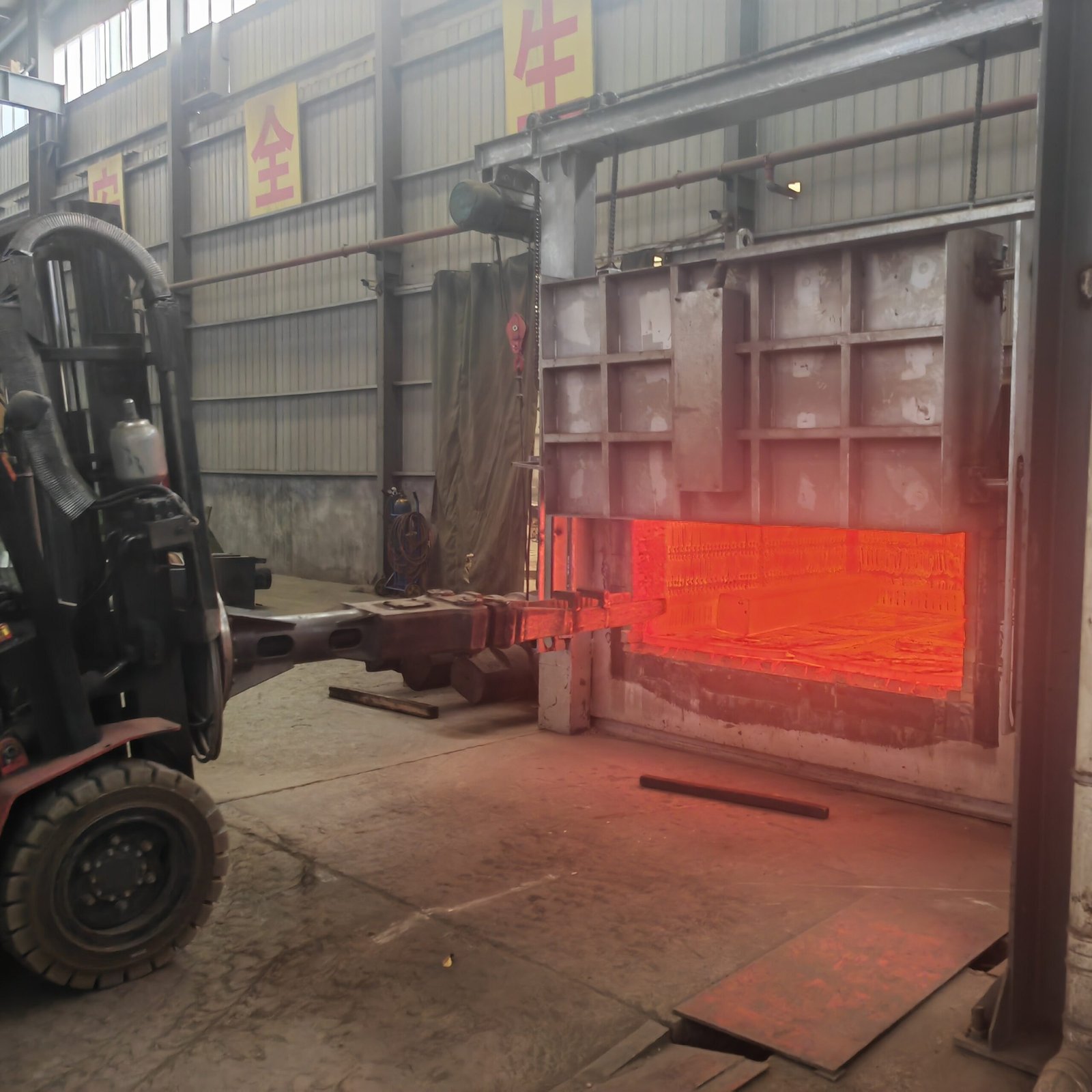Titanium is a cornerstone in aerospace engineering, known for its strength, lightweight, and exceptional heat resistance. In jet engines, where performance and reliability are key, titanium enhances efficiency and safety.
Jet engines operate under extreme conditions, subjecting components to intense temperatures and mechanical stresses. Titanium's ability to withstand temperatures up to 600°C without compromising structural integrity makes it indispensable for critical engine parts such as turbine blades, compressor discs, and exhaust systems. Titanium's heat resistance extends component lifespan, improves fuel efficiency, and enhances reliability.

This article explores the significance of titanium in aerospace, specifically focusing on its role in heat-resistant jet engine components. We delve into the design principles, advanced manufacturing techniques, performance benefits, and future innovations surrounding titanium's application in modern aviation. Additionally, we explore how titanium drives aerospace advancements, ultimately meeting the increasing demands for better performance, efficiency, and sustainability in air travel.
Join us as we uncover the importance of heat resistance in titanium jet engine components and explore the transformative impact of this remarkable material on the future of aerospace engineering.


1.Properties of Titanium Relevant to Aerospace
Titanium's unique properties make it ideal for aerospace, especially in jet engines.Understanding these properties is crucial for appreciating why titanium is chosen over other materials for critical components in aircraft:
- Strength-to-Weight Ratio: Titanium is renowned for its exceptional strength-to-weight ratio, being as strong as steel but nearly half its weight. This characteristic enables significant weight savings in aircraft structures and components, contributing to improved fuel efficiency and operational performance.
- Corrosion Resistance: Titanium exhibits outstanding corrosion resistance, especially in environments involving saltwater or atmospheric conditions. This property ensures longevity and reliability in aerospace applications, where exposure to harsh elements is common.
- High Temperature Performance: One of the most crucial properties of titanium in aerospace is its ability to withstand high temperatures. Specifically, titanium, with a melting point of 1,668°C and an operational limit of 600°C, retains its integrity under extreme heat, making it essential for jet engine components.
- Fatigue Resistance: Titanium demonstrates excellent fatigue resistance, which enables it to endure repeated stress cycles without structural degradation. As a result, this property is vital for maintaining safety and reliability in aircraft subjected to varying operational conditions and loads.
- Biocompatibility: While primarily used in structural applications in aerospace, titanium's biocompatibility further makes it suitable for medical applications such as implants. This inherent property therefore underscores titanium's versatility and reliability across diverse industries.
- Machinability: Despite its toughness, titanium is machinable using advanced techniques such as CNC machining and EDM (Electrical Discharge Machining). This property facilitates precise manufacturing of complex aerospace components, ensuring dimensional accuracy and performance reliability.
- Low Thermal Expansion: Titanium exhibits a low coefficient of thermal expansion, which minimizes dimensional changes under temperature variations. This property contributes to the stability and predictability of aerospace components, particularly critical in high-precision applications.
These properties explain why titanium is preferred in aerospace, combining strength, lightweight, corrosion resistance, heat performance, and machinability. These characteristics enable the development of advanced and efficient aerospace technologies, ensuring safety, reliability, and performance excellence in modern aircraft.
2.Heat Resistance Challenges in Jet Engines
Jet engines operate in extreme conditions where temperatures can exceed 600°C, presenting significant challenges for materials used in their construction. Understanding these challenges is essential for appreciating why materials like titanium are critical in aerospace applications:
- High Temperature Environments: Jet engines generate intense heat during operation, particularly in combustion chambers and turbine sections. Materials must withstand temperatures well beyond those experienced by conventional engines, requiring exceptional heat resistance properties.
- Thermal Stress and Fatigue: The cyclic nature of heat exposure in jet engines subjects materials to thermal stress and fatigue.Expansion and contraction cycles weaken conventional materials, requiring those with better thermal stability and fatigue resistance.
- Oxidation and Corrosion: Elevated temperatures in jet engines increase the susceptibility of materials to oxidation and corrosion. Oxidation occurs when materials react with oxygen in the air, forming oxides that weaken structural integrity. Corrosion can also result from chemical reactions with combustion by-products and environmental factors.
- Creep Resistance: Creep is the gradual deformation of materials under constant stress at high temperatures. Turbine blades and exhaust nozzles in jet engines face prolonged stress at high temperatures, needing materials with high creep resistance for stability and strength.
- Material Compatibility with Fuel and Lubricants: Jet engines use fuels and lubricants that chemically interact with materials at high temperatures.Material selection must consider compatibility to avoid degradation, contamination, or performance loss.
- Thermal Cycling Effects: Rapid temperature changes during engine start-up and shutdown cycles impose thermal cycling effects on materials. These thermal shocks can induce cracking, distortion, or premature failure in components not designed to handle such thermal gradients.
Solving heat resistance challenges requires materials with high melting points, thermal conductivity, oxidation resistance, and strength at high temperatures. In this regard, titanium's unique combination of these properties makes it an ideal choice for critical components in jet engines, thus ensuring reliability, durability, and performance under extreme operating conditions in aerospace applications.
3.Design and Manufacturing Processes
Designing and manufacturing titanium components for jet engines requires meticulous attention to detail and specialized processes to ensure optimal performance and reliability:
3.1 Design Considerations
- Material Selection: Titanium alloys are chosen based on specific performance requirements, including strength, heat resistance, and weight reduction goals.
- Structural Integrity: Designs focus on maintaining structural integrity under high mechanical and thermal loads, ensuring components can withstand operational stresses.
- Optimized Geometry: Geometry is optimized to enhance aerodynamics, minimize weight, and maximize efficiency without compromising strength or durability.
3.2 Manufacturing Techniques
- Casting: Titanium components are often cast using precision investment casting techniques to achieve complex shapes and minimize material waste.
- Forging: Forging shapes titanium under high pressure and temperature, improving grain structure and mechanical properties for load-bearing components.
- Machining: CNC machining and EDM ensure precise dimensional accuracy and surface finish.
- Additive Manufacturing: Additive manufacturing (3D printing) creates intricate geometries with shorter lead times and less material waste.
3.3 Quality Control Measures
- Non-Destructive Testing (NDT): Ultrasonic, radiographic, and dye penetrant testing detect flaws and ensure material integrity.
- Dimensional Inspection: Precision measuring tools and coordinate measuring machines (CMMs) verify dimensional accuracy and adherence to design specifications.
- Material Testing: Tensile, hardness, and fatigue tests validate material properties under simulated conditions.
- Certification and Compliance: Meeting aerospace standards (ASTM, AMS) and customer specs ensures safety, quality, and regulatory compliance.
3.4 Advanced Manufacturing Technologies
- Laser Cutting and Welding: Laser technology cuts and welds titanium precisely, minimizing heat-affected zones and preserving material properties.
- Surface Treatments: Coatings and surface treatments improve wear, corrosion resistance, and thermal barrier properties, extending component lifespan.
Designing and manufacturing titanium jet engine components involves a multidisciplinary approach, integrating advanced materials science, engineering principles, and manufacturing expertise. Consequently, these processes ensure that titanium components meet the stringent performance, reliability, and safety standards essential for aerospace applications.
4.Performance Benefits and Efficiency
Titanium jet engine components offer significant advantages that contribute to enhanced performance, efficiency, and reliability in aerospace applications:
4.1 Weight Reduction and Fuel Efficiency
- Titanium's exceptional strength-to-weight ratio allows for significant weight savings compared to traditional materials like steel or nickel alloys.
- Reduced component weight translates to lower fuel consumption and improved overall fuel efficiency, critical for optimizing aircraft performance and operating costs.
4.2 High Temperature Performance
- Titanium's ability to withstand temperatures up to 600°C without compromising structural integrity is crucial for components exposed to high heat in jet engines.
- Enhanced heat resistance minimizes thermal expansion and maintains dimensional stability, contributing to prolonged component lifespan and reliability under extreme operating conditions.
4.3 Durability and Longevity
- Titanium's corrosion resistance and fatigue strength ensure long-term durability and extended service life in harsh aerospace environments.
- Components such as turbine blades, compressor discs, and exhaust systems benefit from reduced wear and degradation, improving operational reliability and maintenance intervals.
4.4 Enhanced Engine Performance
- Titanium components contribute to improved engine performance by minimizing internal friction, optimizing airflow dynamics, and enhancing combustion efficiency.
- Precision-engineered titanium parts facilitate smoother operation, reduced vibration, and increased power output, resulting in enhanced overall engine performance and operational efficiency.
4.5 Environmental Sustainability
- Reduced fuel consumption and lower emissions associated with titanium's lightweight properties contribute to environmental sustainability efforts in aviation.
- Improved fuel efficiency and operational reliability align with industry initiatives for reducing carbon footprint and achieving sustainable aviation goals.
4.6 Operational Flexibility and Safety
- Titanium's high strength and reliability under extreme conditions provide operational flexibility and safety margins for aircraft operations.
- Enhanced component performance ensures reliable operation in varied flight profiles, climates, and scenarios, improving flight safety and mission success.
Titanium jet engine components offer benefits like weight reduction, fuel efficiency, heat resilience, durability, and reliability. These advantages collectively underscore titanium's pivotal role in advancing aerospace technology, thereby improving aircraft performance metrics and meeting evolving industry demands for efficiency and sustainability.
5. Case Studies and Applications
Exploring real-world applications and case studies demonstrates the practical benefits and performance of titanium jet engine components across various aerospace contexts:
5.1 Example 1: Titanium Alloy Turbine Blades
As the "heart" of modern jet engines, titanium turbine blades offer significant lightweight advantages. Titanium's high strength-to-weight ratio provides these blades with reduced mass, thereby decreasing rotational inertia and enhancing engine responsiveness. For instance, titanium-aluminum turbine blades in the GE9X engine reduce weight while also improving high-temperature performance. Moreover, titanium-aluminum alloys resist oxidation and creep, enabling stable high-temperature operation, which in turn improves efficiency and reduces fuel consumption.
5.2 Example 2: Titanium Alloy Exhaust Systems
Similarly, titanium exhaust systems play a crucial role as the "cleanup crew" in jet engines. Specifically, titanium alloys resist corrosion in high-temperature exhaust gases, thus extending the exhaust system's lifespan. A notable example is the titanium alloy exhaust system used in the Boeing 787 Dreamliner. In addition, titanium's low thermal conductivity helps cool exhaust systems, ultimately protecting other engine parts from heat damage.
5.3 Example 3: Titanium Alloy Compressor Discs
Titanium compressor discs are the "rotating heart" of jet engines. Titanium alloys' fatigue and corrosion resistance ensure stable performance under high-speed rotation and harsh conditions.Titanium compressor discs in the Airbus A350 enhance engine reliability and reduce noise. This is because the damping characteristics of titanium alloys help absorb vibrations, thereby reducing operational noise during engine operation.
These cases show how titanium jet engine parts improve aircraft efficiency, reliability, and performance. They underscore titanium's critical role in advancing aerospace engineering and meeting evolving industry demands for high-performance materials in aviation.
6. Future Trends and Innovations
Looking ahead, ongoing advancements in materials science and aerospace engineering are driving the evolution of titanium jet engine components towards enhanced performance, efficiency, and sustainability:
6.1 Advanced Titanium Alloys
- Innovation: Ongoing research in titanium alloys seeks to improve strength, heat resistance, and fatigue properties.
- Benefits: Improved alloys will create lighter, stronger components, reducing weight, boosting fuel efficiency, and increasing reliability.

6.2 Additive Manufacturing (3D Printing)
- Innovation: Additive manufacturing enables complex geometries and custom titanium designs, reducing lead times and material waste.
- Benefits: Additive manufacturing allows rapid prototyping, on-demand production, and advanced cooling channels, optimizing performance and efficiency.
6.3 Composite Materials Integration
- Innovation: Hybrid materials combining titanium with composites or ceramics offer better stiffness, fatigue resistance, and thermal stability.
- Benefits: Composite integration reduces weight, maintains structural integrity, saves fuel, and extends component life in aerospace.
6.4 Smart Materials and Sensors
- Innovation: Smart materials and sensors in titanium components enable real-time monitoring of structural health, temperature, and stress.
- Benefits: Improved monitoring and predictive maintenance boost efficiency, reduce downtime, and enhance safety by detecting failures early.
6.5 Environmental Sustainability Initiatives
- Innovation: Aerospace manufacturers are increasingly focused on developing titanium components that contribute to reducing carbon emissions and environmental impact.
- Benefits: Lightweight titanium parts boost fuel efficiency, while sustainable manufacturing and recycling improve the environmental impact of titanium.
6.6 Digital Twin and Simulation Technologies
- Innovation: Digital twin simulations and advanced modeling optimize titanium component design, manufacturing, and performance prediction throughout their lifecycle.
- Benefits: Virtual testing and predictive analytics ensure performance, reliability, and safety, speeding innovation and reducing time-to-market for aerospace technologies.
6.7 Regulatory Compliance and Certification
- Innovation: Adhering to strict aerospace standards (e.g., ASTM, AMS) ensures titanium component safety, quality, and reliability, meeting global regulations.
- Benefits: Certification processes validate performance characteristics and material properties, instilling confidence in titanium's suitability for critical aerospace applications and fostering industry-wide adoption.
Titanium jet engine components stand at the forefront of aerospace innovation, offering unparalleled performance, efficiency, and reliability in modern aircraft propulsion systems. Throughout this exploration of titanium's capabilities:
- Performance Advantages: Titanium's exceptional strength-to-weight ratio and heat resistance enable significant weight savings, enhanced fuel efficiency, and improved operational performance in jet engines.
- Technological Advancements: From advanced alloy formulations to additive manufacturing techniques, ongoing innovations continue to push the boundaries of what titanium can achieve in aerospace applications.
- Sustainability and Safety: Titanium's contributions to environmental sustainability through reduced fuel consumption and emissions align with industry goals for greener aviation technologies. Moreover, its robustness ensures safe and reliable operation in demanding flight conditions.
- Future Prospects: Emerging trends in materials science, such as smart materials integration and digital twin technologies, promise further advancements in optimizing titanium component design, manufacturing, and performance monitoring.
- Industry Leadership: Aerospace manufacturers and researchers are poised to harness these innovations to drive forward the next generation of aircraft propulsion, leveraging titanium's unique properties to meet the evolving demands of global aviation.
In conclusion, titanium jet engine components epitomize the intersection of cutting-edge technology, engineering excellence, and sustainability in aerospace. As the industry continues to evolve, titanium remains a cornerstone material, paving the way for safer, more efficient, and environmentally responsible air travel worldwide.
As a trusted supplier of semi-finished titanium products, Young Things Metal Co. Ltd. is proud to contribute to these advancements, providing the materials that make these technological achievements possible.
Share this article
Written by : 钛合金网
Follow us
Table Of Content



